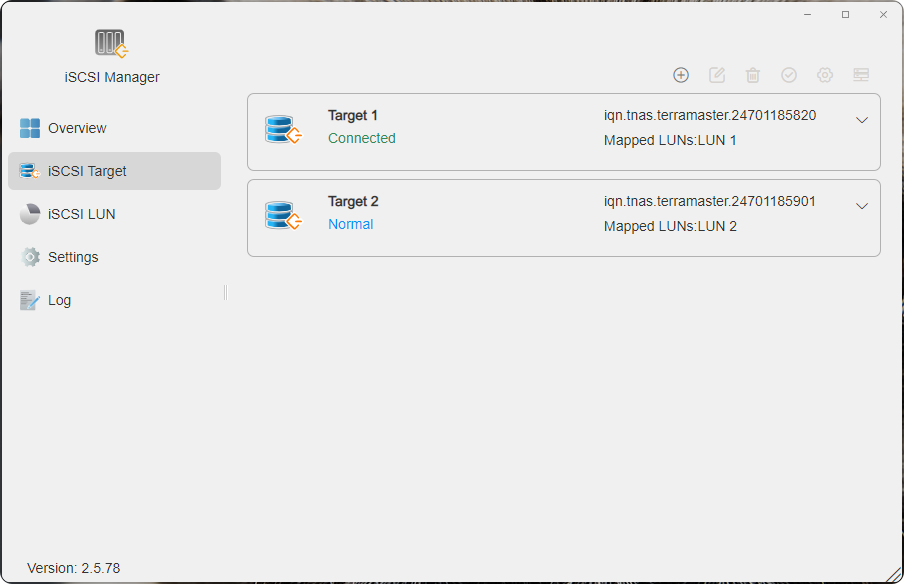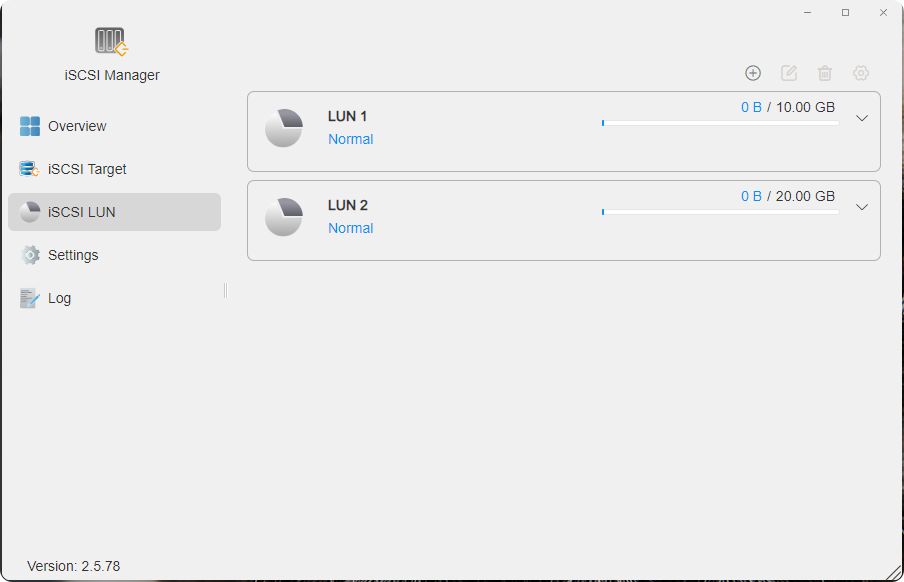iSCSI Manager
iSCSI Manager —— NAS is widely used as an extension for virtualization storage. TerraMaster iSCSI Manager allows you to create multiple iSCSI Targets and LUNs on your TNAS, and customize capacity, permissions, and connections via a graphical interface to meet your storage needs in different virtualization environments.
iSCSI —— is a standard storage networking protocol based on IP, suitable for connecting to multiple data storage devices. iSCSI runs SCSI commands over IP networks, enabling data transmission across LANs (Local Area Networks) and WANs (Wide Area Networks). With iSCSI, the client computer’s operating system treats the space on the storage server as a local hard drive. In fact, the data written to that “hard drive” is transmitted over the network to the storage server.
iSCSI Target and iSCSI LUN —— In SCSI terminology, LUN (Logical Unit Number) refers to an individually addressable SCSI logical device, which is part of a physical SCSI device (called a "Target"). An iSCSI environment simulates the connection to a SCSI disk. The iSCSI Target acts like a connection interface, while the LUN is essentially a numbered hard disk. When an iSCSI initiator (client) connects to an iSCSI Target, all LUNs mapped to that Target are also connected to the client’s operating system. Therefore, the initiator can create and manage file systems on these iSCSI LUNs just like managing unformatted SCSI or IDE hard drives.
Overview
Displays the number of total iSCSI Targets, connected iSCSI Targets, total iSCSI LUNs, and healthy iSCSI LUNs.

iSCSI Target
You can create and manage iSCSI Targets.

Create iSCSI Target
- Click "Create".
- Enter the Target information, including Name, IQN, and whether to enable CHAP authentication. Click "Next".
- In Advanced Settings, choose whether to enable CRC/Checksum and Allow Multiple Connections. Click "Next".
- Confirm all configurations are correct, then click "Confirm".
- IQN: IQN (iSCSI Qualified Name) is the unique name of the Target. It must not conflict with Targets on other servers. It must be fewer than 128 characters, and may include letters (case-insensitive), numbers, colons, dashes, and dots. Recommended format:
iqn.[domain]:[device-identifier], e.g.,iqn.tnas.terramaster.24504184153. - Mutual CHAP authentication: Client and server authenticate each other. The CHAP password for the client and server must not be the same. If CHAP is enabled, the iSCSI initiator’s discovery process may fail. It is recommended to complete discovery first, then enable CHAP.
- CRC/Checksum: Used to verify if there are errors during data transmission.
- Allow Multiple Connections: Allows multiple initiators to connect to the same Target simultaneously. To prevent data corruption, it is recommended to use this with file-sharing or clustering systems (e.g., VMware VMFS, Oracle OCFS).
Manage iSCSI Target
- Edit: Modify the iSCSI Target.
- Delete: Delete the iSCSI Target.
- Disable/Enable: Disable or enable the iSCSI Target.
- Settings: Configure network interfaces allowed to access the iSCSI Target.
- Mapping: Select the LUNs to map to the iSCSI Target.
iSCSI LUN
You can create and manage iSCSI LUNs.

Create iSCSI LUN
- Click "Create".
- Set the LUN properties: including Name, Location, Capacity, Space Allocation, Mapping Target. Click "Next".
- Configure Host and Initiator access permissions. Click "Next".
- Confirm the configuration is correct, then click "Confirm".
- Thick Provisioning: Allocates the full capacity when creating the LUN. Offers higher performance, suitable for high-performance scenarios.
- Thin Provisioning: Allocates space on demand and supports snapshots. Only consumes storage when actually used, providing flexibility.
Manage iSCSI LUN
- Edit: Modify iSCSI LUN properties.
- Delete: Delete iSCSI LUN.
- Settings: Configure FUA support and SCSI command cache synchronization/I/O policy.
- One iSCSI Target can be mapped to one or more iSCSI LUNs.
- After an iSCSI LUN is created, its capacity can be increased but not decreased.
Settings
- Port: The default port is 3260.
- iSNS: iSNS (Internet Storage Name Service) provides a centralized management mechanism. You can register all iSCSI Targets on an iSNS server. Check the box to enable it, enter the server IP, then click "Apply".
- I/O Queue Depth: Default is 128, adjustable as needed.
- Low Capacity Protection: When enabled, if storage space runs low, the LUN will automatically unmount during write operations to prevent file system corruption.